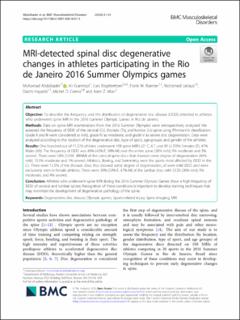| dc.contributor.author | Abdalkader, Mohamad | |
| dc.contributor.author | Guermazi, Ali | |
| dc.contributor.author | Engebretsen, Lars | |
| dc.contributor.author | Roemer, Frank W. | |
| dc.contributor.author | Jarraya, Mohamed | |
| dc.contributor.author | Hayashi, Daichi | |
| dc.contributor.author | Crema, Michel D. | |
| dc.contributor.author | Mian, Asim Z. | |
| dc.date.accessioned | 2020-07-10T06:06:46Z | |
| dc.date.available | 2020-07-10T06:06:46Z | |
| dc.date.created | 2020-06-03T21:44:07Z | |
| dc.date.issued | 2020 | |
| dc.identifier.citation | BMC Musculoskeletal Disorders. 2020, 21, Article 45. | en_US |
| dc.identifier.issn | 1471-2474 | |
| dc.identifier.uri | https://hdl.handle.net/11250/2663626 | |
| dc.description | This article is distributed under the terms of the Creative Commons Attribution 4.0 International License (http://creativecommons.org/licenses/by/4.0/), which permits unrestricted use, distribution, and reproduction in any medium, provided you give appropriate credit to the original author(s) and the source, provide a link to the Creative Commons license, and indicate if changes were made. The Creative Commons Public Domain Dedication waiver (http://creativecommons.org/publicdomain/zero/1.0/) applies to the data made available in this article, unless otherwise stated. | en_US |
| dc.description.abstract | Objective: To describe the frequency and the distribution of degenerative disc disease (DDD) detected in athletes who underwent spine MRI in the 2016 Summer Olympic Games in Rio de Janeiro. Methods: Data on spine MRI examinations from the 2016 Summer Olympics were retrospectively analyzed. We assessed the frequency of DDD of the cervical (Cs), thoracic (Ts), and lumbar (Ls) spine using Pfirrmann’s classification. Grade II and III were considered as mild, grade IV as moderate, and grade V as severe disc degeneration. Data were analyzed according to the location of the degenerative disc, type of sport, age-groups, and gender of the athletes. Results: One hundred out of 11,274 athletes underwent 108 spine MRI’s (21 C, 6 T, and 81 L) (53% Females (F), 47% Males (M)). The frequency of DDD was 40% (42% F, 58% M) over the entire spine (28% mild, 9% moderate and 3% severe). There were 58% (12%F, 88%M) of the cervical spine discs that showed some degree of degeneration (44% mild, 13.5% moderate and 1% severe). Athletics, Boxing, and Swimming were the sports most affected by DDD in the Cs. There were 12.5% of the thoracic discs that showed some degree of degeneration, all were mild DDD and were exclusively seen in female athletes. There were 39% (53% F, 47% M) of the lumbar discs with DDD (26% mild, 9% moderate, and 4% severe). Conclusion: Athletes who underwent spine MRI during the 2016 Summer Olympic Games show a high frequency of DDD of cervical and lumbar spines. Recognition of these conditions is important to develop training techniques that may minimize the development of degenerative pathology of the spine. | en_US |
| dc.language.iso | eng | en_US |
| dc.subject | degenerative disc disease | en_US |
| dc.subject | olympic games | en_US |
| dc.subject | sports-related injury | en_US |
| dc.subject | spine imaging | en_US |
| dc.subject | MRI | en_US |
| dc.title | MRI-detected spinal disc degenerative changes in athletes participating in the Rio de Janeiro 2016 Summer Olympics games | en_US |
| dc.type | Peer reviewed | en_US |
| dc.type | Journal article | en_US |
| dc.description.version | publishedVersion | en_US |
| dc.rights.holder | © The Author(s). 2020 | en_US |
| dc.source.pagenumber | 8 | en_US |
| dc.source.volume | 21 | en_US |
| dc.source.journal | BMC Musculoskeletal Disorders | en_US |
| dc.identifier.doi | 10.1186/s12891-020-3057-3 | |
| dc.identifier.cristin | 1813727 | |
| dc.description.localcode | Institutt for idrettsmedisinske fag / Department of Sports Medicine | en_US |
| cristin.ispublished | true | |
| cristin.fulltext | original | |
| cristin.qualitycode | 1 | |
